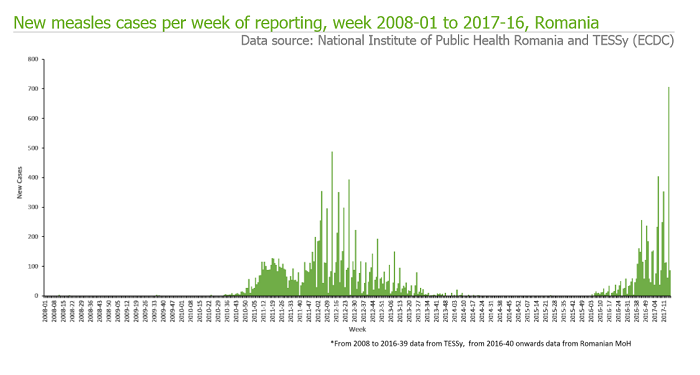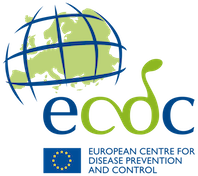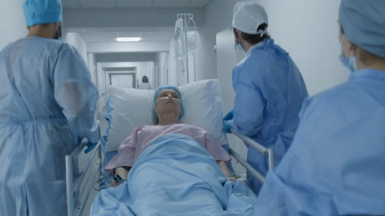Epidemiological update: Measles - monitoring European outbreaks, 28 April 2017Archived
A measles outbreak in Romania has been ongoing since February 2016 and cases continue to be reported despite ongoing response measures that have been implemented at national level through reinforced vaccination activities. Between 1 January 2016 and 21 April 2017, Romania reported 4 881 cases. In 2016, a number of additional EU/EEA countries reported measles outbreaks, and an increase in the number of cases continues to be observed in 2017. Some previous and ongoing measles outbreaks in other EU countries have been epidemiologically linked to the current outbreak in Romania.
Weekly Update
In EU countries, measles cases have been reported in 2017 in Austria, Belgium, Bulgaria, Czech Republic, Denmark, France, Germany, Hungary, Iceland, Italy, Portugal, Slovakia, Spain and Sweden as well as in Romania, where 4 881 cases had been reported as of 21 April 2017.
In non-EU countries, measles cases have been reported in 2017 in Afghanistan, Australia, Canada, Central African Republic, Ethiopia, Guinea, Liberia, Nigeria, Pakistan, Somalia, South Sudan, Switzerland, Syria, Ukraine and USA.

Epidemiological summary EU Countries with updates since last week
Belgium
Since 20 December 2016 and as of 16 April 2017, Wallonia reported 288 cases of which 163 confirmed, 81 probable, and 44 are clinical (ECDC 2012 definition). The outbreak affects all provinces of Wallonia, with the exception of the province of Luxembourg. Thirty-seven cases are among healthcare workers (31 confirmed, four probable, two possible). Of the 288 cases, 111 (38%) were hospitalised. Two cases of had acute encephalitis. No deaths are reported.
The index case of the epidemic in Wallonia travelled to Romania during the incubation period. In Flanders, one isolated imported case was reported in January and another in March, with possible links to a cluster in Wallonia. In the Brussels Capital Region, one isolated imported case was reported in February and two cases were notified in March without known links to the epidemic in Wallonia. Both imported cases had a travel history to Romania during the incubation period, and the national reference centre for measles, mumps and rubella (WIV-ISP) identified genotype B3, which is the same strain found in Romania, Italy and Austria, at the end of 2016.
Bulgaria
Since mid-March 2017 and as of 24 April, media in Bulgaria has reported 65 cases, of which 37 are confirmed, in the city of Plovdiv. This represents an increase by four cases since the last report. On 9 April 2017, Bulgaria reported one death of a 10month-old unimmunised child.
Germany
Since the beginning of 2017 and as of 9 April 2017, Germany has reported 462 cases This is an increase by 52 cases since the previous update. In the same period in 2016, Germany reported 30 cases.
Italy
Since the beginning of 2017 and as of 23 April, Italy has reported 1 739 cases, with 159 cases among healthcare workers. The cases are reported from 18 of the 21 regions in Italy. Most of the cases are above the age of 15 years and 88% of the cases were not vaccinated, 33% reported one or more complications, 39% were hospitalised.
Portugal
Since the beginning of 2017 and as of 26 April 2017, Portugal has reported 25 confirmed cases, of which 16 (64%) are older than 18 years of age, 15 (60%) were unvaccinated, 12 (48%) are health professionals and 12 (48%) were hospitalised. One death has been reported.
Romania
Between 1 January 2016 and 21 April 2017, Romania has reported 4 881 cases of measles, including 22 deaths. Cases are either laboratory-confirmed or have an epidemiological link to a laboratory-confirmed case. Infants and young children are the most affected population. Thirty-eight of the 42 districts have reported cases, Caras Severin (West part of the country, at the border with Serbia) being the most affected district with 943 cases. Vaccination activities are ongoing in order to cover communities with suboptimal vaccination coverage. On 25 April, media reported an additional death, bringing the number of deaths to 23.
Slovakia
On 24 April 2017, Slovakia reported an imported case of measles. The case is a 25-year-old, unvaccinated Italian who studies in Kosice. The last endemic cases in the Slovak Republic were reported in 1998 and the last imported cases of measles were reported in 2011 and 2012.
EU countries with no updates since the last week
Austria
Since the beginning of 2017 and as of 12 April, Austria has reported 71 cases, which exceeds the cumulative number of cases reported in 2016.
Denmark On 15 March 2017, Denmark reported an imported case of measles in an unvaccinated adult who was infected during a holiday in Asia.
On 15 March 2017, Denmark reported an imported case of measles in an unvaccinated adult who was infected during a holiday in Asia.
Czech republic
As of 10 April 2017, 38 cases of measles have been reported in the Moravian-Silesian region of the Czech Republic. Twenty of the cases are children below the vaccination age and 18 are adults. Of the 18 adults, six are healthcare workers. According to media, a hospital has been closed due to hospital staff being infected.
France
Since 1 January and as of 31 March 2017, France reported 134 cases, three times more than the number of reported cases in 2016 over the same period. The cases are mainly linked to an epidemic outbreak in Lorraine (60 cases). Two cases of encephalitis and 15 severe pneumopathies have been recorded since the beginning of the year.
Hungary
Between 21 February and 22 March 2017, Hungary reported 54 cases of measles. The health authorities have lifted the quarantine from the hospital in Mako, southeast Hungary, as no new cases were detected in two weeks.
Iceland
On 31 March, Iceland reported two cases in two 10-month-old twin siblings. The infants were unvaccinated. The first case was diagnosed 10 days before the second case. This is the first time in a quarter of a century that measles infection has occurred in Iceland.
Spain
An outbreak started in the first week of January in Barcelona metropolitan area, due to an imported measles case from China. As of 27 March, 44 cases have been confirmed. Most of the cases are unvaccinated or incompletely vaccinated adults. Four of the cases are children, and ten cases were hospitalised.
Sweden
Since the beginning of 2017 and as of 21 March 2017, Sweden reported 15 cases of measles, including three imported cases.
Outside the EU
Afghanistan
As of 31 March 2017, Afghanistan has reported 73 measles outbreaks for the first quarter of the year.
Australia
As of 7 April, Australia has reported 49 cases of measles in 2017, from New South Wales (23), Western Australia (12), Queensland (8), Victoria (4) and the Northern Territory (2). The median age of the cases is 18 years with a range of 0 to 47 years.
Canada
As of 9 April 2017, Canada has reported 31 cases of measles, resulting from nine separate import events. Nova Scotia reported that due to two imported cases, 23 secondary cases have occurred in February and March.
Central African Republic Since the beginning of 2017 and as of 4 April 2017, Central African Republic has reported over 50 cases of measles in the prefectures of Lobaye in the south, Ouaham and Ouaham Pendé in the north. Twenty cases are in serious condition.
Ethiopia
Since the beginning of 2017 and as of 2 April, Ethiopia has reported 1 100 cases of measles, of which 496 are confirmed. Measles campaign targeting around 22.5 million children have been conducted since February.
Guinea
Since the beginning of 2017 and as of 19 April, Guinea has reported 5 262 cases of measles, of which 3 906 are confirmed. Nineteen cases died. The weekly incidence of cases declined by 68% in the last three weeks. Approximately 242 cases were reported in the week ending April 14, compared to a peak with 746 cases in mid-March. Vaccination campaign in Conakry ended on 17 April 2017. Preparation for a vaccination campaign in the remaining 21 health districts is on-going.
Liberia
Since the beginning of the year and as of 16 April 2017, Liberia has reported 576 suspected cases of which 487 were tested: 45 positive, 416 negative and 26 equivocal, while 89 were compatible and epi-linked. From the negative cases, 188 samples have been tested for rubella, out of which 97 were positive. There are more suspected cases reported in Liberia in 2017 compared to 2016.
Nigeria
Since the beginning of the year and as of March 2017, Nigeria has reported 51 cases of measles. Media, quoting The Nasarawa State Government, reported that between January and the beginning of April 2017, 15 deaths due to measles, mainly children, are notified.
Pakistan
Between January and March 2017, in Pakistan four provinces have reported cases: Punjab(174), Sindh(1008)n Sindh, KPK (Khyber Pakhtunkhwa) (279) and Balochistan (94).
Somalia
Since the beginning of the year and as of 25 April, Somalia has reported almost 5 700 cases of measles. This number is higher than the number of cases reported during the same period last year.
South Sudan
Since January 2017, 560 suspect measles cases including four deaths have been reported from 18 counties. Five counties confirmed measles outbreaks since the beginning of 2017. The overall downtrend continues. A measles vaccination campaign is scheduled for 17 – 28 April 2017.
Switzerland
Since the beginning of 2017 and as of 16 April, Switzerland reported 61 cases of measles.
Syria
In March 2017, Idleb in northwest Syria reported 91 cases since the beginning of 2017.
Ukraine
On 24 April 2017, Ukraine reported 13 cases of measles hospitalised in Ivano-Frankivsk in the west of Ukraine. Twelve of the cases are children under the age of 15 years.
USA
As of 26 April 2017, Minnesota Department of Health has reported 24 confirmed cases of measles among Somali Minnesotan children in Hennepin County.
ECDC assessment
Measles outbreaks continue to occur in EU/EEA countries, and there is the risk of spread and sustained transmission in areas with susceptible populations. The national vaccination coverage remains less than 95% for the second dose of MMR in the majority of EU/EEA countries. The progress towards elimination of measles in the WHO European Region is assessed by the European Regional Verification Commission for Measles and Rubella Elimination (RVC). Member States of the WHO European Region are making steady progress towards the elimination of measles. At the fifth meeting of the RVC for Measles and Rubella in October 2016, of 53 countries in the WHO European Region, 24 (15 of which are in EU/EEA) were declared to have reached the elimination goal for measles, and an additional 13 countries (nine in the EU/EEA) were concluded to have interrupted endemic transmission for between 12 and 36 months, meaning they are on their way to achieving the elimination goal. However, six EU/EEA countries were judged to still have endemic transmission of measles: Belgium, France, Germany, Italy, Poland and Romania.
More information on strain sequences would allow further insight into the epidemiological investigation. All EU/EEA countries report measles cases on a monthly basis to ECDC and these data are published every month. Since 10 March 2017, ECDC has been reporting on measles outbreaks in Europe on a weekly basis through epidemic intelligence activities.
Actions ECDC published a rapid risk assessment on 6 March. ECDC monitors measles transmission and outbreaks in the EU/EEA on weekly basis through enhanced surveillance and epidemic intelligence activities.
Actions
ECDC published a rapid risk assessment on 6 March. ECDC monitors measles transmission and outbreaks in the EU/EEA on weekly basis through enhanced surveillance and epidemic intelligence activities.







